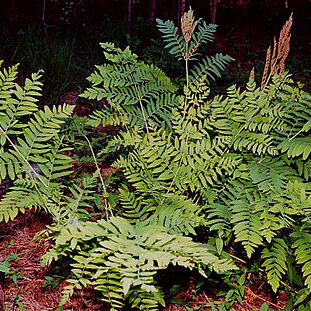Terrestrial ferns. Rhizomes thick, erect, covered with persistent stipe bases. Fronds 1-2-pinnate, covered with hairs when very young, wholly or partially dimorphic; veins free. Sporangia in dense clusters, replacing the lamina of some or all the pinnae on fertile fronds. Spores trilete.
Plants terrestrial. Stems creeping; tips often somewhat erect. Leaves dimorphic; fertile leaves erect, often notably smaller than sterile leaves in length and width. Blades 1--2-pinnate; pinnae monomorphic to dimorphic, pinnatifid or pinnate.
Fertile pinnae quite different from sterile, lacking a green lamina; lamina of sterile pinnae not translucent
Coarse ferns with pinnate-pinnatifid or bipinnate lvs. 10, cosmop

